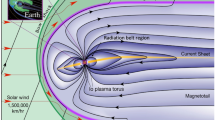Abstract
A Radiation Belt Monitor (RBM) sensitive to protons and electrons with energy ≳0.5 MeV1 has been designed for the High Energy Transient Experiment (HETE) satellite in order to: first, control the on-off configuration of the experiments (i.e. those susceptible to proton damage); and second, to indicate the presence of proton and/or electron events that could masquerade as legitimate high energy photon events. One of the two RBM channels has an enhanced sensitivity to electrons. Each channel of the RBM, based on a PIN silicon diode, requires a typical power of 6 milliwatts. Tests have been performed with protons with energies from ∼0.1 to 2.5 MeV (generated by a Cockcroft-Walton linear accelerator via the d(d,p)t reaction), and with electrons with energies up to 1 MeV (from a 1.0 µCi207Bi source).
Similar content being viewed by others
References
A ctually, due to the finite thickness of the detector, there are also upper energy limits for the detection of protons and electrons. The limit for protons is ∼50 MeV. The stopping power of protons with energy ≳50 MeV is small enough that they deposit less than the 0.5 MeV threshold energy in the active layer of the detector. This issue is important because the energy spectra of protons and electrons found in low earth orbits extend to energies of order 10 to 100 MeV.3
G. Ricker, J. Doty, S. Rappaport,et al., inNuclear Spectroscopy of Astrophysical Sources, edited by N. Gehrels and G. Share, AIP Conference Proceedings No. 170, AIP Press, N.Y., 407 (1988) and references therein.
E. G. Stassinopoulos inHigh-Energy Radiation Background in Space, edited by A. C. Rester, Jr. and J. I. Trombka, AIP Conference Proceedings No. 186, AIP Press, N.Y., 3 (1989).
In fact, compared to the proton channel, the electron channel with its higher reverse bias voltage can detect protons and electrons with higher energies. This is because the electron channel PIN diode has a thicker depletion layer and, thus, a higher upper energy limit.
T. Murakami, private communication, (1993).
J. A. Coleman, D. P. Love, J. H. Trainor, and D. J. Williams, IEEE Trans. Nucl. Sci. NS-15, no. 3, 363 (1968).
E. G. Stassinopoulos and J. M. Barth,ASTRO-D Charged Particle Environment Study, NASA X-900-91-07 (1991). The satellite ASCA was formerly named ASTRO-D.
K. W. Wenzel, D. H. Lo, R. D. Petrasso,et al., Rev. Sci. Instrum.63, 4837 (1992).
C. M. Lederer and V. S. Shirley,Table of Isotopes, 7th ed., Wiley, New York (1978).
J. M. McKenzie and G. T. Ewan, IRE Trans. Nucl. Sci.NS-8, no. 1, 50 (1961).
L. Pages, E. Bertel, H. Joffre, and L. Sklavenitis,Energy loss, range, and bremsstrahlung yield for 10-keV to 100-MeV electrons in various elements and chemical compounds, Atomic Data4, 1–127 (1972).
Author information
Authors and Affiliations
Rights and permissions
About this article
Cite this article
Lo, D.H., Wenzel, K.W., Petrasso, R.D. et al. A radiation belt monitor for the high energy transient experiment satellite. Exp Astron 4, 59–75 (1993). https://doi.org/10.1007/BF01581814
Received:
Accepted:
Issue Date:
DOI: https://doi.org/10.1007/BF01581814




